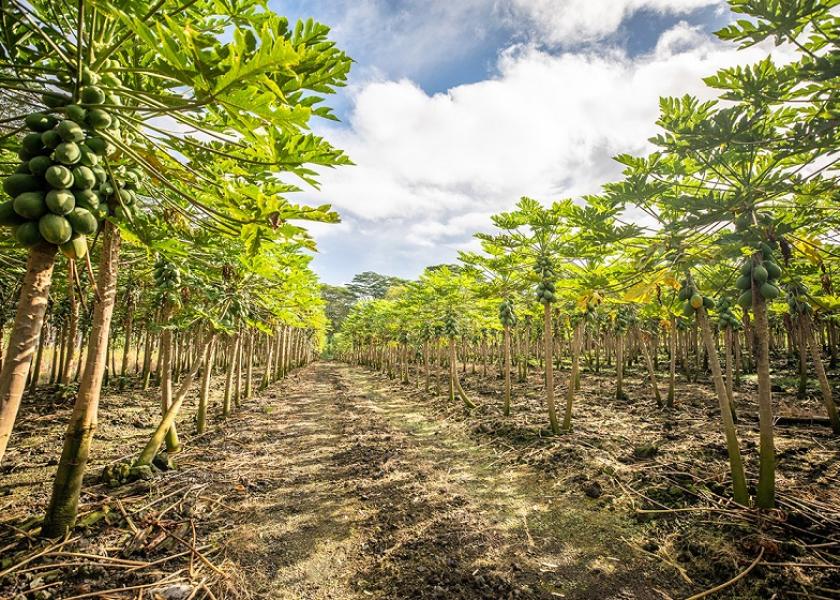Hawaiian papaya growers overcome challenges, chart a future course

Sure, Hawaiian papayas had a comeback year in 2021. But the fruit has never gone away.
The output of Hawaiian papayas totaled 13.4 million pounds in 2021, up 62% from 2020 and the state’s highest output since 2017, the USDA reports.
Eric Weinert, president of the Hawaiian Papaya Industry Association, believes the state’s 100 or so commercial producers grow the best-tasting papaya in the world.
The year-round papaya crop, much of it grown on the lava soils of the Big Island of Hawaii in the Puna area, is consumed on the island, the U.S. mainland and also in export markets such as Canada and Japan. The 60% or so of the crop that is shipped to the U.S. mainland is treated with vapor heat to remove the threat of fruit flies.
“No matter where we go, they say Hawaiian papaya tastes the best,” Weinert said. In fact, at a recent trade show, he said some South American producers were boasting that their fruit was the “pride of Hawaii.”
“They stole their papaya seed from Hawaii,” he explained. “Even when people take our seed, it doesn’t taste as good as it does here.”
The porous, mineral-rich soils produce papaya trees that can bear fruit just one year after being planted. The trees soar up to 25 feet tall after just three years.
Besides promoting jaw-dropping growth of papaya trees, the rich and fertile lava soil gives the fruit its great flavor, Weinert said.
Commercial shipments of Hawaiian papaya are sold in 10-pound boxes, with sizes mostly ranging from 5 to 10 fruits per carton.
Weinert, who moved to Hawaii in 1979, said he also personally benefits from the bounty of the state.
“I am actually spending a lot of time just growing a lot of my own food here on the island right now; I'm having pineapple, banana and papaya for breakfast, and it's all from my yard,” he said on a recent morning.
Previously, Weinert helped to start a tropical fruit nursery and build an electronic irradiator for starfruit and rambutan. He later ran Calavo’s papaya program in Hawaii, and retired from that position last year.
There are three large papaya shippers on the island, with Calavo being the biggest of those three.
Growers produce the biotech Rainbow variety in Hawaii. On the association’s website, the group said the genetically engineered Rainbow papaya saved the Hawaii papaya industry from near extinction in the 1990s.
That’s when the papaya ringspot virus, a plant virus, decimated papaya farms on Oahu and Hawaii Island, the website recalls.
Cornell scientists joined with University of Hawaii researchers and figured out a way to use the genetic portion of the virus to “inoculate” papayas against the disease.
With unanimous approval by the U.S. government, papaya farmers across the state began planting Rainbow papaya in 1998.
Without biotechnology, there would be very little — if any — papaya grown in Hawaii today, the group says.
“There's a little gene that just blocks the expression of that virus, and that's protected us,” Weinert said. “For 20 years, we've sold over a quarter of a billion pounds of papaya without a single health incident.”
Hawaii-grown Rainbow papayas have been distributed across the U.S. since 1998, Canada since 2003, and, most recently, to Japan, according to the group.
Weinert said the story with Hawaiian papayas now is the great taste and high nutritional value of the fruit, with chart-topping numbers for potassium and vitamins C and A.
“It always ranks in the top five of healthy fruits,” he said. Great taste and nutrition represent a powerful one-two punch for Hawaiian papaya, he said.
Supply chain challenges
The COVID-19 pandemic brought challenges for the state's growers, however.
At the start of the pandemic, papaya growers who needed local labor to help with harvest couldn’t compete with government payments that allowed people not to work, Weinert said. Labor troubles have eased, but plenty of issues remain.
“The big challenge today is rising fuel costs and fertilizer costs,” he said, noting that growers generally must import all their inputs. Shrinking food budgets for people who have limited funds also is a worry.
A mix of air and boat transportation is used to transport Hawaiian papaya to the mainland, and Weinert said the pandemic interrupted some air deliveries. For example, FedEx cut the frequency of its service to the Big Island during the pandemic.
There are now probably more boat shipments than air shipments of papayas to the mainland from Hawaii, he said.
Weinert said he has started a business called Hawaii Papaya Direct that delivers 5-count cartons of papayas to individual consumers through FedEx air service for a cost of about $50 per carton.
With ocean shipments of Hawaiian fruit to the mainland taking about 10 days on the water, the lure of air shipments is freshness, Weinert said.
Papayas in a Hawaii Papaya Direct order can be picked Sunday, leave the state on Tuesday and be in a consumer’s home anywhere in the U.S. by Thursday, he said.
“We are able to actually take the ripest, most perfect fruit that would be too ripe to ship by boat and send it directly to consumers. For people who have tired papaya, they love it,” he said, noting that 60% of Hawaii Papaya Direct customers elect to subscribe and receive the fruit on a regular basis, varying from every week to every month.
Looking ahead, Weinert said the direct-to-consumer model may increase for Hawaiian papayas, as the pandemic has made more people comfortable in receiving food at their homes.
High-end retail demand also will continue. What’s more, Weinert noted that Costco is now stocking Hawaiian papaya in stores in Canada and Southern California.







